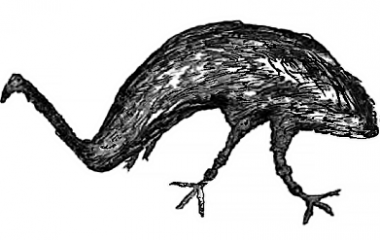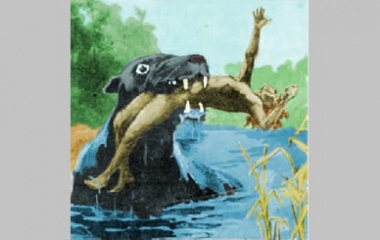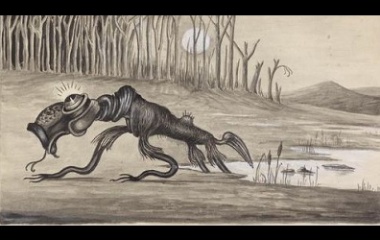Australia, the island continent, is famous for its huge swathes of untouched wilderness and for the unique, often deadly animals that wander there. You wouldn’t expect that a nation with the likes of the platypus and the killer box jellyfish would need to invent a new creature to add to its allure, yet reports of a mysterious, massive creature lurking in the waters of Australia abound. This creature, the Bunyip, is as much a part of Australian culture as any of its other fantastic beasts.
What is the Bunyip?
The Bunyip is an Australian water monster, sometime described as a ferocious predator and other times as a gentle herbivore. He has been part of Aboriginal tradition for centuries, and he continues to be a favorite character in Australian fiction today.
Characteristics
Physical Description
Descriptions of the Bunyip vary so wildly that many scholars believe he is just a nominal catch-all for an assortment of different, regional monsters, who have been described as everything from a giant starfish to a crocodile with a dog-like head. Feathers, fins, tusks, claws, beards, a duck bill, a horse tail, a single massive eye, and a stomach-mouth have all been attributed to this bizarre creature. In fact, the only thing that witnesses can seem to agree on is his size: big enough to be a man-eater.
Habitat
The Bunyip’s territory is far-flung, with sightings of him reported all over the Australian continent. He dwells in swamps, lakes, rivers, and even in aquatic environments that routinely drain during the dry season, like waterholes and billabongs. Although he is typically considered to be an aquatic creature, he has been sighted lumbering over land as well.
Special Abilities
Although the word Bunyip means “devil” or “evil spirit” in the Aboriginal language, native Australians disagree about this creature’s disposition. Certainly, his monstrous appearance and his booming cries, which echo across the Australian landscape, color him nightmarish. And his legend even comes with a small death-toll. He has been accused of killing several Aborigine people, usually by “hugging them to death.” Still, he is described by others as a benevolent protector of Australia’s wildlife, rather than a bloodthirsty predator with a taste for human flesh.
Whether for good or for evil, most native Australians do believe that this water creature has supernatural powers. He may be able to alter the water level in his home environment, or he might use his ferocious roar to cripple unwelcome visitors. One legend describes the monster hypnotizing a woman and keeping her for several weeks as his slave, until the spell was broken by a large thunderstorm.
Cultural Representation
Origin
The Bunyip darkened the folklore of Australia’s Aboriginal people for centuries before it made its debut in the written records of European settlers, who bought into the legend wholeheartedly. Originally, the monster went by a different name in each indigenous tribe: the Wowee-wowee, the Yaa-loo, the Kianpraty, the Dongu, and more. When Europeans got their hands on these various monsters, they united them under the single most popular name: Bunyip.
Sightings and Fossils
The earliest documented evidence of the Bunyip is a set of huge, mysterious bones found by the famous explorer Hamilton Humes in 1818. Humes didn’t name these bones as the Bunyip, instead believing that they might have come from a manatee or hippopotamus. However, the scholars who heard about his discovery couldn’t help but think of the monster described by Aborigine people, and the Philosophical Society of Australasia offered to pay Humes to return the lake where he had found the skeleton and transport it to their headquarters. Humes declined.
In 1830, another set of bones were unearthed in Wellington Cave. The anatomist Sir Richard Owen identified these bones as belonging to a giant, extinct marsupial species, at the same time noting that the surrounding tribes had a tradition about a similar giant creature living in nearby waterways.
In 1845, the Geelong Advertister announced yet another fossil discovery, this time claiming that the fossil had been identified by an Aborigine man as belonging to a previously unknown species: the Bunyip. This story kickstarted a firestorm of monster sightings across Australia.
In 1847, a bizarre skull was found and attributed to the now extremely popular monster. Although experts identified the skull as belonging to a deformed fetal calf, it was accepted into the Australian Museum in Sydney, where it was displayed as evidence of the Bunyip. The display was wildly popular, until the skull was mysteriously stolen from the museum. Another slurry of sightings followed in the wake of the museum’s display, but by the end of the 1850s, the monster’s fame had entered a slump.
Modern Connotation
Today, the Bunyip is largely regarded as no more than a charming bit of folklore. He is usually portrayed as a gentle giant, and he has even starred in children’s books and television series.
Interestingly, the monster’s name has also picked up some political connotation. It can be used as a derogatory term to belittle political movements that are made up of “imposters” or “humbug.” During the 1850s, it was used to mock “the bunyip aristocracy,” a group of European settlers who aspired to create a new class in Australian society. In the 1930s, the word was used again as an attack on the Liberal Party of Australia.
Explanation of the Myth
Even though most Australians today believe that the Bunyip is purely mythological, a small pocket of cryptozoologists still cling to the numerous fossils and sightings of Australia’s watery monster.
The most popular theory names the Diprotodon, a giant marsupial which has been extinct in Australia for over 46,000 years, as the famous water beast. Passionate believers claim that this massive marsupial still lurks in Australia’s rugged outback, while more moderate believers claim that Aborigine people may have a cultural memory of the Diprotodon, a sort of oral tradition which has been handed down from generation to generation and accepted as true by each new generation.
Elephant seals and leopard seals have also been proposed as explanations. If these seals somehow found their way inland, they could easily terrify native people with their size and their loud barks.










